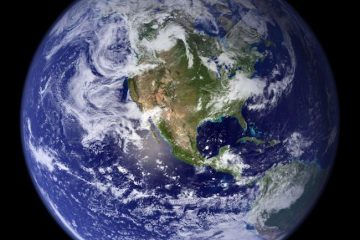In the realm of ecological philosophy and scientific inquiry, few theories resonate as profoundly as the Gaia Hypothesis proposed by the visionary mind of James Lovelock. This groundbreaking concept challenges conventional views of Earth as a mere collection of disparate elements, instead painting a portrait of our planet as a living, self-regulating organism. Join us on a journey through the captivating origins, intricate details, and lingering questions surrounding the Gaia Hypothesis, as we delve into the symbiotic relationship between Earth and all its inhabitants.
Table of Contents
- Exploring the Gaia Hypothesis by James Lovelock
- Unveiling the Intricacies of Gaia Theory in Environmental Science
- The Impact of Gaia Hypothesis on Modern Ecological Perspectives
- Practical Applications of James Lovelock’s Gaia Hypothesis in Sustainability
- Q&A
- Key Takeaways

Exploring the Gaia Hypothesis by James Lovelock
James Lovelock’s Gaia Hypothesis presents a fascinating perspective on the interconnectedness of Earth’s systems and life forms. By viewing the planet as a single, self-regulating entity, Lovelock’s theory challenges traditional scientific boundaries and invites us to rethink our relationship with the environment.
Exploring this revolutionary concept, we are prompted to consider the intricate web of interactions that sustain life on Earth. Through **feedback loops** and **dynamic equilibrium**, the Gaia Hypothesis highlights the delicate balance that exists between living organisms and their environment, emphasizing the importance of preserving this harmony for the well-being of all beings.

Unveiling the Intricacies of Gaia Theory in Environmental Science
In the realm of environmental science, the Gaia Theory, coined by James Lovelock, delves into the interconnectedness of Earth’s systems and life forms. This holistic approach views Earth as a self-regulating organism, where the biosphere, geosphere, atmosphere, and hydrosphere interact to maintain a stable and conducive environment for life to thrive.
<p>At the core of the Gaia Theory lies the idea that Earth functions as a single, unified entity with various feedback mechanisms that work in harmony. This theory challenges traditional views of Earth as a passive environment and instead portrays it as an active, self-regulating system that undergoes constant evolution. By understanding the intricacies of Gaia Theory, scientists aim to comprehend the complex web of interactions that contribute to the sustainability of life on our planet.</p>The Impact of Gaia Hypothesis on Modern Ecological Perspectives
The Gaia hypothesis proposed by James Lovelock has had a profound impact on shaping modern ecological perspectives, revolutionizing the way we view the interconnectedness of Earth’s systems. This hypothesis suggests that the Earth functions as a self-regulating organism, where living organisms and their inorganic surroundings form a complex system that maintains the conditions necessary for life.
By highlighting the Earth as a single, self-regulating entity, the Gaia hypothesis challenges traditional views of nature as a passive backdrop to life, emphasizing the dynamic and interconnected nature of environmental processes. This perspective encourages a reevaluation of human interactions with the environment, promoting a more holistic approach to ecological sustainability and stewardship.

Practical Applications of James Lovelock’s Gaia Hypothesis in Sustainability
The Gaia hypothesis proposed by James Lovelock has sparked significant interest in the realm of sustainability, offering a unique perspective on the interconnectedness of Earth’s systems and life forms. One practical application of this hypothesis is the promotion of holistic approaches to environmental conservation and management. By viewing the Earth as a self-regulating organism, individuals and organizations can better understand the impact of human activities on ecological balance.
<p>Furthermore, embracing the Gaia hypothesis can inspire innovative solutions for sustainable living, such as:</p>
<ul>
<li><strong>Regenerative Agriculture:</strong> Implementing farming practices that prioritize soil health and biodiversity to enhance ecosystem resilience.</li>
<li><strong>Urban Green Spaces:</strong> Creating green infrastructure within cities to improve air quality, reduce heat island effects, and promote biodiversity.</li>
<li><strong>Renewable Energy Adoption:</strong> Transitioning towards clean energy sources to reduce carbon emissions and mitigate climate change.</li>
</ul>Q&A
**Q&A: Unveiling the Remarkable Gaia Hypothesis by James Lovelock**
Q: What is the Gaia Hypothesis proposed by James Lovelock?
A: The Gaia Hypothesis, envisioned by James Lovelock, suggests that the Earth functions as a self-regulating system, akin to a living organism, where biotic (living) and abiotic (non-living) components interact to maintain conditions conducive to life.
Q: How did James Lovelock come up with the Gaia Hypothesis?
A: Lovelock, a pioneering environmental scientist, drew inspiration from his work for NASA, observing the Earth from space. This unique perspective led him to perceive the planet as a single, interconnected entity capable of regulating its own environment.
Q: What are the key principles of the Gaia Hypothesis?
A: Central to the Gaia Hypothesis is the concept of homeostasis, where Earth’s various systems work together to sustain life by adjusting key environmental factors such as temperature, atmospheric composition, and ocean salinity.
Q: How does the Gaia Hypothesis impact our understanding of the environment?
A: By viewing Earth as a self-regulating organism, the Gaia Hypothesis emphasizes the delicate balance and interdependence of all living and non-living elements on the planet, highlighting the importance of preserving this intricate harmony for the well-being of all life forms.
Q: What are the criticisms and debates surrounding the Gaia Hypothesis?
A: While the Gaia Hypothesis has sparked intriguing discussions in the scientific community, it has also faced criticism for being anthropocentric and overly metaphorical. Some argue that attributing intentionality to Earth’s systems may oversimplify complex ecological processes.
Q: How can the Gaia Hypothesis influence our approach to environmental conservation?
A: Understanding the Earth as a dynamic, self-regulating entity can inspire us to adopt more holistic and sustainable practices in managing our environment. Embracing the principles of Gaia could lead to more harmonious coexistence with nature and a renewed sense of responsibility towards the planet.
Key Takeaways
In a world where the delicate balance between nature and humanity is often overlooked, the Gaia Hypothesis proposed by James Lovelock serves as a poignant reminder of our interconnectedness with the planet we call home. As we delve into the depths of this fascinating theory, we are confronted with the awe-inspiring complexity and harmony of Earth’s ecosystems.
Through Lovelock’s lens, we are encouraged to see Earth not merely as a passive backdrop to human existence but as a living, self-regulating organism in its own right. The Gaia Hypothesis challenges us to reevaluate our relationship with the natural world and strive for a more symbiotic coexistence with all living beings.
As we ponder the profound implications of Lovelock’s visionary hypothesis, let us embrace a newfound sense of reverence for the interconnected web of life that sustains us all. May we walk lightly upon the Earth, honoring its intricate beauty and acknowledging our place within its intricate tapestry. In the spirit of Gaia, let us nurture and protect our planet, ensuring a vibrant and sustainable future for generations to come.



0 Comments